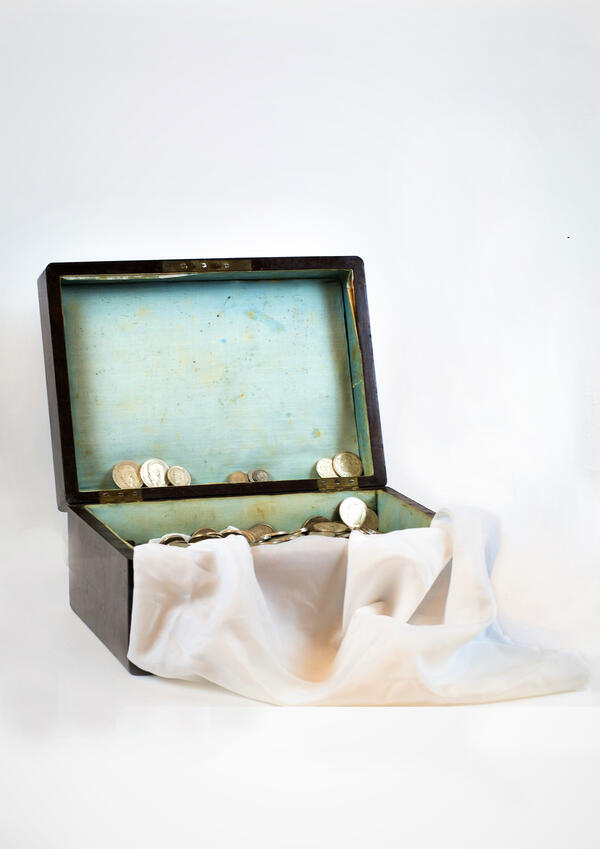In 1994, in the cellar of the house 37 on Pervomaiskaya Street, the hoard was found, which subsequently became a museum item.
According to archival records, the two-story house with a shop and a stone outbuilding used to belong to the Murom merchant Vasily Myazdrikov. His family was actively engaged in trade. For example, the son of the owner, Ivan Myazdrikov, according to the documents of 1914, had a grocery store, in which he sold grape wines.
The main part of the hoard is money. It is 1393 silver coins of different value — rubles, 50, 20, 15, and 10 kopecks. The earliest coin is dated 1867, while the latest ones were issued in 1915. All of them were regular issues and heavily worn out, as they had been in use for a long time.
The hoard also includes cutlery and household items dating back to the last third of the 19th century. The oldest item is an infant feeding horn made by a Moscow jeweler in 1873. These funnel-shaped devices existed even before our time and were known in the ancient times, and served as a prototype for a baby-feeding bottle in the future. They were made of different materials: glass, pottery, bone or horns of cattle. In Russia, these items cast from silver appeared in the 17th — 19th centuries and were quite rare.
The stamp of a master on the horn housed in the museum is faded, but experts suggest that it was made at the Moscow factory of Ivan Chichelev, one of the largest enterprises at the turn of the 19th — 20th centuries. Chichelev was a supplier to the Imperial House, to the King of Italy and to the Austrian Emperor. He participated many times in world exhibitions in London, Paris, Vienna and Philadelphia. The master became known for his jewelry with enamels and precious stones made in the Russian-Byzantine style.
The hoard’s latest item is a miniature money box dated 1899 — 1908, which was produced at the Moscow gold and silverware workshop of Viktor Flink. It is an authentic item with the stamp of the workshop. Flink was a Hamburg citizen, but moved to Russia and accepted Russian citizenship. He was engaged in the manufacture of kitchenware and religious objects. He was considered one of the best jewelers in Moscow. Flink decorated his jewelry with carved images with European patterns.
According to archival records, the two-story house with a shop and a stone outbuilding used to belong to the Murom merchant Vasily Myazdrikov. His family was actively engaged in trade. For example, the son of the owner, Ivan Myazdrikov, according to the documents of 1914, had a grocery store, in which he sold grape wines.
The main part of the hoard is money. It is 1393 silver coins of different value — rubles, 50, 20, 15, and 10 kopecks. The earliest coin is dated 1867, while the latest ones were issued in 1915. All of them were regular issues and heavily worn out, as they had been in use for a long time.
The hoard also includes cutlery and household items dating back to the last third of the 19th century. The oldest item is an infant feeding horn made by a Moscow jeweler in 1873. These funnel-shaped devices existed even before our time and were known in the ancient times, and served as a prototype for a baby-feeding bottle in the future. They were made of different materials: glass, pottery, bone or horns of cattle. In Russia, these items cast from silver appeared in the 17th — 19th centuries and were quite rare.
The stamp of a master on the horn housed in the museum is faded, but experts suggest that it was made at the Moscow factory of Ivan Chichelev, one of the largest enterprises at the turn of the 19th — 20th centuries. Chichelev was a supplier to the Imperial House, to the King of Italy and to the Austrian Emperor. He participated many times in world exhibitions in London, Paris, Vienna and Philadelphia. The master became known for his jewelry with enamels and precious stones made in the Russian-Byzantine style.
The hoard’s latest item is a miniature money box dated 1899 — 1908, which was produced at the Moscow gold and silverware workshop of Viktor Flink. It is an authentic item with the stamp of the workshop. Flink was a Hamburg citizen, but moved to Russia and accepted Russian citizenship. He was engaged in the manufacture of kitchenware and religious objects. He was considered one of the best jewelers in Moscow. Flink decorated his jewelry with carved images with European patterns.




